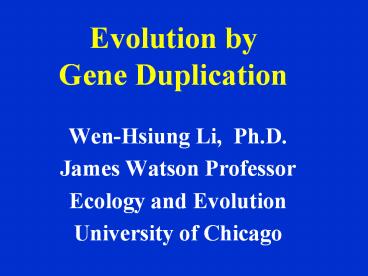Evolution by Gene Duplication - PowerPoint PPT Presentation
Title:
Evolution by Gene Duplication
Description:
... Lactate dehydrogenase (LDH), aldolase, creatine kinase ... and tyrosine. Olfactory receptors The ... size Yeast C. elegans ... – PowerPoint PPT presentation
Number of Views:146
Avg rating:3.0/5.0
Title: Evolution by Gene Duplication
1
Evolution by Gene Duplication
- Wen-Hsiung Li, Ph.D.
- James Watson Professor
- Ecology and Evolution
- University of Chicago
2
Topics
- Increase in gene number from simple to complex
organisms - Evolutionary significance Why gene duplication?
- Examples of duplicate genes
- Loss of duplicate genes
- Conclusions
3
of genes
Prokaryotes
Haemophilus influenzae
1790
E. coli
5380
6000
Yeast
19,700
Nematode
Fruitfly
13,770
Ciona intestinalis
10,990
(Sea squirt)
Chicken
17,710
Eukaryotes
Human
22,200
4
(No Transcript)
5
Why Gene Duplication?
- Producing more of the same
- Functional fine-tuning
- Functional diversity
- Creation of a new gene from a redundant duplicate
6
Producing more of the same
- The normal physiology of an organism may
require many copies of a gene. - Example
- The translational machinery of an organism
usually requires many transfer RNA (tRNA) genes
and ribosomal RNA (rRNA) genes.
7
No. of rRNA and tRNA genes in a genome
- Genes Mitochondrion E. coli Human
- (mammals)
- Proteins 13 5380
22,200 - 18S rRNAs 1 7
300 - tRNAs 22 85
500
8
Response to stress
- Multi-drug resistance (P-glycoprotein) (mdr)
genes - Amplification of mdr genes often occurs in
cancer cells after a patient has been treated
with drugs. - Insecticide resistance
- Multiple copies of esterase genes have been
found in mosquito populations treated with
insecticide.
9
Functional fine-tuning
- Isozymes Enzymes that catalyze the same
biochemical reaction but may differ from one
another in biochemical properties, tissue
specificity, and developmental regulation - Are encoded by duplicate genes
- Examples Lactate dehydrogenase (LDH), aldolase,
creatine kinase
10
Lactate dehydrogenase (LDH)
Catalyzes the conversion between lactate and
pyruvate
11
LDH isozymes
- LDH tetramer (consisting of 4 subunits)
- A and B subunits are encoded by two separate
genes - A4, A3B, A2B2, AB3, B4
- B4, AB3 function better in aerobic
- tissues such as heart
- A4, A3B function better in anaerobic
- tissues such as skeletal muscle
12
Developmental sequence of five LDH isozymes in
rat heart
13
Functional diversity
- Immunoglobulins Antibody diversity
- Major Histocompatibility Complex (MHC) genes
14
Immunoglobulins
- Immunoglobulin 2 light chains and
- 2 heavy chains
- 2 types of light chain kappa lambda
- 5 types of heavy chain mu, delta, gamma (4
subtypes), epsilon and alpha. - The type of heavy chain defines the class of
immunoglobulin - IgM, IgD, IgG, IgE and IgA
15
16
17
Over 15,000,000 combinations of Variable,
Diversity and Joining gene segments are possible.
Imprecise recombination and mutation increase the
variability into billions of possible
combinations.
18
Enhancing or expanding existing function
- Color vision genes
- Hemoglobin genes
19
(No Transcript)
20
(No Transcript)
21
Pygmy chimp or bonobo
22
Trichromatic color vision
from Backhaus, 1998
23
Wavelength (nm)
A person with only a short-wave and a middle-wave
photo-receptor
24
- Vision of most mammals (dichromats)
- a. Short wave opsin (blue)
- b. Long or middle wave opsin (red/green)
X-linked autosome
25
Origin of routine trichromacy
26
(No Transcript)
27
Hemoglobin
- In human and mammals
- A tetramer consisting of two a and two ß
globin chains - In jawless fish
- A monomer and only 1 globin gene
- Polymerization occurred probably after gene
duplication
28
Advantages of being a tetramer
- Allows hemoglobin to bind oxygen in a
cooperative fashion The binding of the first
oxygen molecule facilitates the binding of
subsequent oxygen molecules. - Conversely, release of the first oxygen
molecule facilitates the release of subsequent
molecules. - As an oxygen carrier in blood it must load
and unload oxygen molecules at the right partial
oxygen pressure.
29
30
(No Transcript)
31
Types of hemoglobin in humans
- In the embryo ?2e2 and a2e2
- In the fetus Hemoglobin F (a2?2)
- In adults
- Hemoglobin A (a2ß2) - Most common type
- Hemoglobin A2 (a2d2) - d chain synthesis
begins late in the third trimester and in adults,
it has a normal level of 2.5 - Hemoglobin F (a2?2) - In adults it is
restricted to a limited population of red cells
32
Monomer
Monomer
33
Creation of a new gene from a redundant duplicate
gene
- Myoglobin and hemoglobin
- Trypsin and chymotrypsin
- Olfactory receptors
- Hox genes
- Pax genes
34
Hemoglobin Oxygen carrier in blood. Myoglobin
Oxygen carrier in tissues. It has a higher oxygen
affinity than hemoglobin.
35
Trypsin and chymotrypsin
- Digestion of protein in the intestine is
carried out by trypsin and chymotrypsin. - Trypsin attacks the peptide bond at the basic
amino acids lysine and arginine, whereas
chymotrypsin attacks the peptide bond at the
carboxyl side of the aromatic amino acids
phenylalanine and tyrosine.
36
1,500 million years ago
37
Olfactory receptors
- The detection of small molecules plays an
important role in the survival of most animals,
which use odor to identify and evaluate their
food, predators, and territory. - The olfactory system is important for our
quality of life. A unique odor can trigger
distinct memories from our childhood or from
emotional moments positive or negative. When
something tastes good it is mainly due to
activation of the olfactory system.
38
The vivid world of odors A Nobel Prize (2004)
was given to Richard Axel and Linda Buck for
their discoveries of odorant receptors and the
organization of the olfactory system.
39
Examples of molecules in different odor classes
Smell Molecule Name Chemical Formula Shape
Fruity Ethyl-octanoate C10H20O2
Minty Beta-cyclocitral C10H13O
40
Minty p-anisaldehyde C8H8O2
Nutty,Medicinal 2,6-dimethyl pyrazine C6H8N2
Nutty,Medicinal 4-heptanolide C7H12O2
Nutty,Medicinal p-cresol C7H8O
41
Putative Binding cavity in Human OR1.04.06
42
Binding cavity for retinal in Bovinerhodopsin
1HZX Chain A































